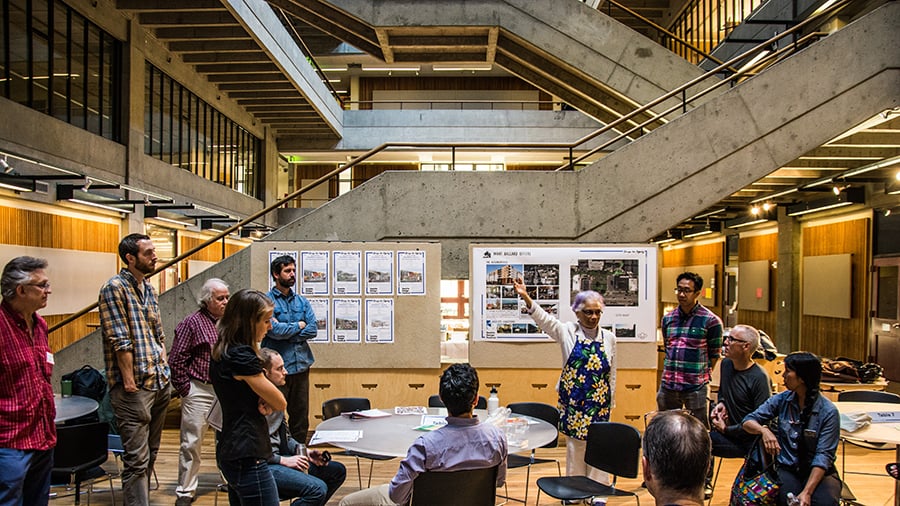
April 4, 2017
How to Get More Minority Students in Architecture? Look to 1968
Columbia University’s radical experiments of the late 1960s were tremendously successful in recruiting and retaining minority students. Can we apply them again today?
Jonathan Isaacs is one of the few African American students who will be graduating with an architectural degree in May from New Jersey Institute of Technology. Over his five years in the professional program, multiple minorities students have dropped out, not just in his school, but across America. While the reasons are many, Issacs thinks there is one obvious issue at hand: the architectural field has done little to make him, or people like him, feel included. “Architecture schools should be more specific about what architecture can be, dispelling the notion of what society thinks the architect looks like and what problems they solve,” says Issacs.
For the past few years, it seems almost every article or initiative on diversity has been concerned with one central question: how can we get more minority students enrolled in institutions of higher education? But the more astute question may be: how do we keep them there? A national study revealed that there is a still a growing gap between the graduating numbers of white and black students. What does this imply about the relationship between architecture schools and their minority students? What aspects of curricula may be pushing students away? Could coursework be undervaluing these students’ unique set of experiences?
According to Sharon Sutton, an AIA Medal award holder, Columbia University Graduate School of Architecture (GSAPP) graduate, and author of When Ivory Towers Were Black: A Story About Race in America’s Cities and Universities, retention rates have much to do with curricula: “One of the problems is that the subjects of some studios just aren’t relevant to [black students in architecture and design]—in addition to the blatant Western canon that everything is valued against.”
In her new book Sutton delivers a riveting account, filled with many oral histories (including her own), of an experiment at GSAPP in the late 1960s. After the 1968 Insurgency—a historic, student-led occupation of Columbia’s campus, demanding the elimination of funding for bomb research and condemning the demolition of a Morningside Heights park to build a new gym—Columbia re-evaluated its curriculum across its schools. Architecture students and professors demanded the school diversify the student body and faculty, yes, but most importantly they wanted to see an overhaul of Columbia’s approach to teaching architecture.

As a result many studios shifted towards a Community Based Learning approach, one which engaged with the local neighborhood. Sutton’s book explains how this new focus was not only relished by residents of Morningside Heights (who otherwise couldn’t afford professional, architectural services) but also boosted up the new African American students (including Sutton) into positions of leadership within the studios. Instead of playing cultural catch-up to their white peers (as might happen in sites like commercial high rises or museums in European cities), Sutton explains that minority students’ knowledge of the needs and values within black communities made them indispensable to the studios. The result was an incredible rate of success, both during school and in professional careers, among the students of color in those experimental years. “An overarching theme among this group was the affirmation they felt in being able to apply their skills purposefully in the local area, developing skills to serve marginalized communities,” Sutton says.
Expressing a similar sentiment, NJIT student Issacs states: “When we have projects based in Newark, I love it. Being someone who is local, my peers look to me as the person with a lot of information. I can start to explain the urban fabric, what wasn’t there, what the changes and struggles were in the last 10 to 15 years.”
In her own tenure as an architectural educator at the University of Washington, Sutton has experimented with other ways, beyond the community based approach, of expanding the breadth of the typical architectural curriculum. She designed a studio course that had students first study and analyze other creative fields where African Americans have made an aesthetic impact, such as art, music, literature and poetry. The frameworks pulled out of those studies were then used to develop the students’ projects for the semester and to challenge them to consider what an African American expression in architecture might look or be programed like.
https://soundcloud.com/archdaily/gsapp-conversations-3-sharon-sutton-mabel-o-wilson
Of course, it’s not just curricula that make a difference in retention rates. As Sutton recently noted in an episode of GSAPP conversations, what helped make Columbia’s initiatives in the late 1960s so successful was not just the broadening of its curriculum, but the broadening of its definition of a “qualified” applicant (who would excel in just such a curriculum):
“By reconsidering the admissions criteria, GSAPP was able to admit students who had other kinds of experiences. They were actually quite qualified, but probably wouldn’t get in today. They had gone to technical high schools, community colleges [or had work experience]. So that, with the economic support, allowed people to attend who cannot attend today—these are the students that have been missing from my classes” says Sutton, who in her 40+ years of teaching has only had 12 African American architecture students.
While community-based projects, more racially explorative courses, and admissions criteria that respect diverse backgrounds aren’t the only ways to interest African American students, understanding their pedagogical value may lead education developers to have a better grasp of how and why minority students study architecture in the first place—and remain through to graduation day. As Sutton’s book decidedly points out, there are ways to enable minority students to succeed, but first one must step outside of architecture’s notorious “eurocentric brainwashing” and begin reevaluating curriculum and admissions practices from the ground up.
Sharon Sutton’s book is now out and available through Fordham University Press





